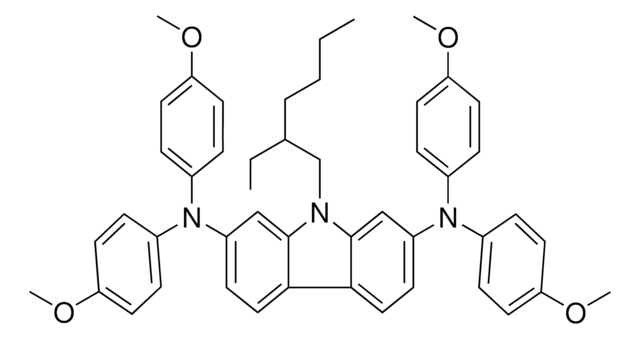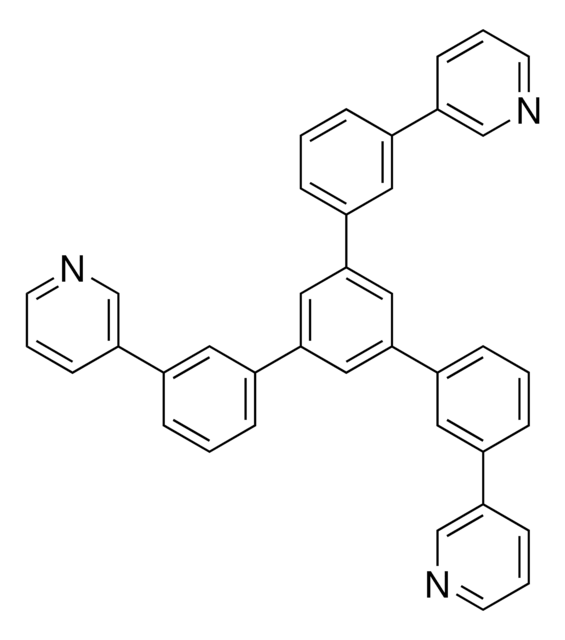907073
PO-T2T
>=99% (HPLC), Mw 909.8 g/mol,
Synonym(s):
(1,3,5-Triazine-2,4,6-triyl)tris(benzene-3,1-diyl)tris(diphenylphosphine oxide), 2,4,6-Tris[3-(diphenylphosphinyl)phenyl]-1,3,5-triazine
About This Item
Recommended Products
product name
PO-T2T, >=99% (HPLC),
grade
sublimed grade (>99% (HPLC))
description
PL-295, 379 nm (in CH2Cl2)
form
solid
mol wt
Mw 909.8 g/mol
color
white
λmax
272 nm in dichloromethane
Orbital energy
HOMO -6.8 eV
LUMO -2.8 eV
storage temp.
15-25°C
Related Categories
Application
ITO/MoO3 (3 nm)/ TAPC (35 nm)/CBP:TTM-3NCz (3.0 wt%; (40 nm) and CBP:TTM3PCz (3.0 wt%; 25 nm)/B3PYMPM (10 nm)/PO-T2T (70 nm)/LiF (0.8 nm)/Al (100 nm).
The first Tandem, All-exciplex-based WOLED was constructed using PO-T2T for a device structure configured by two parallel blend layers of mCP/PO-T2T and DTAF/PO-T2T, generating blue and yellow exciplex emission, respectively. The resulting device demonstrates for the first time a tandem, all-exciplex-based white-light OLED (WOLED) with excellent efficiencies ηext: 11.6%, ηc: 27.7 cd/A, and ηp: 15.8 ml/W with CIE(0.29, 0.35) and CRI 70.6 that are nearly independent of EL intensity. The tandem architecture and blend-layer donor/acceptor (1:1) configuration are two key elements that fully utilize the exciplex delay fluorescence, providing a paragon for the use of low-cost, abundant organic compounds en route to commercial WOLEDs.
An efficient action of radical-based OLEDs, whose emission originates from a spin doublet, rather than a singlet or triplet exciton was demonstrated in a study published in Nature.
While the emission process is still spin-allowed in these OLEDs, the efficiency limitations imposed by triplet excitons are circumvented for doublets. Using a luminescent radical emitter, an OLED with maximum external quantum efficiency of 27% at a wavelength of 710nm-the highest reported value for deep-red and infrared LEDs was achieved. In this very efficient OLEDs, selective hole injection into the HOMO and electron injection to the SOMO was achieved imploying TAPC as the hole transport layer, and PO-T2T as the electron transport layer to form the fluorescent doublet excited state with near-unity internal quantum efficiency.
Storage Class Code
13 - Non Combustible Solids
WGK
WGK 3
Flash Point(F)
Not applicable
Flash Point(C)
Not applicable
Certificates of Analysis (COA)
Search for Certificates of Analysis (COA) by entering the products Lot/Batch Number. Lot and Batch Numbers can be found on a product’s label following the words ‘Lot’ or ‘Batch’.
Already Own This Product?
Find documentation for the products that you have recently purchased in the Document Library.
Articles
Professors Tokito and Takeda share design principles and optimization protocols for organic electronic devices, focusing on flexibility and low cost.
Our team of scientists has experience in all areas of research including Life Science, Material Science, Chemical Synthesis, Chromatography, Analytical and many others.
Contact Technical Service








